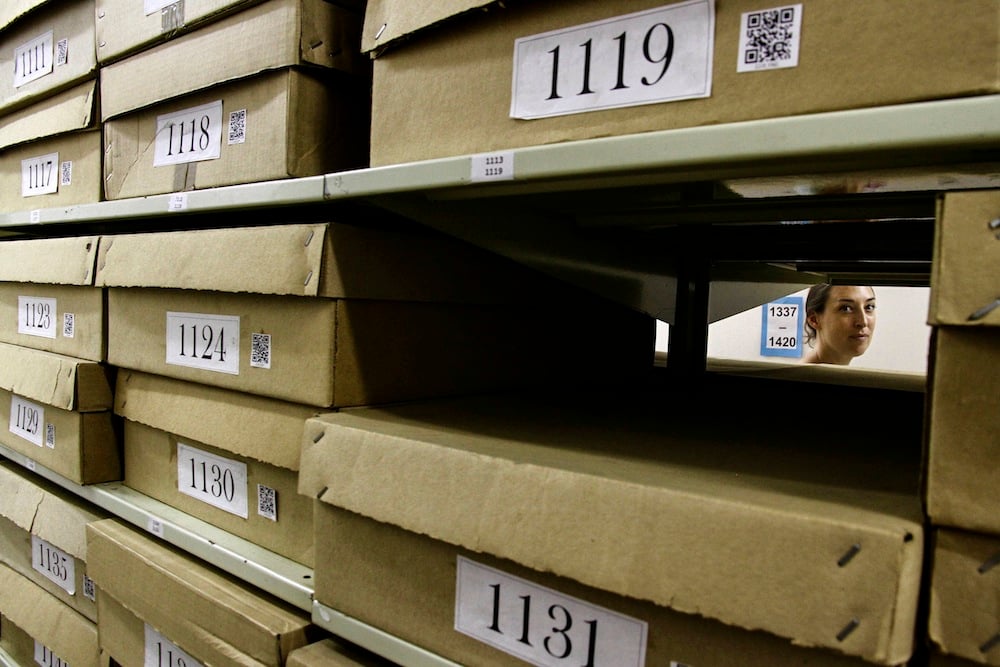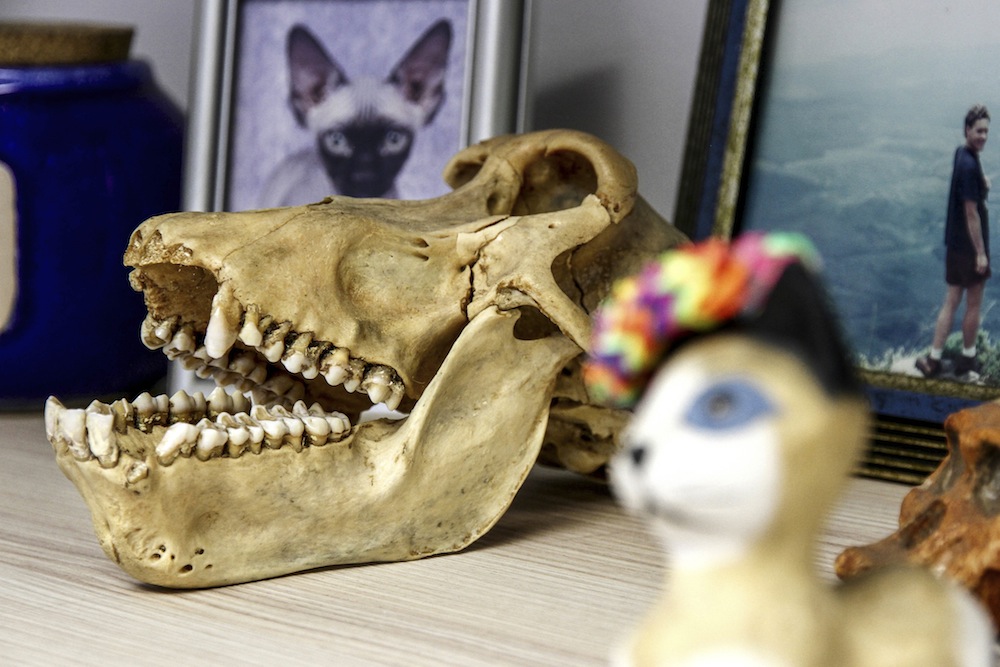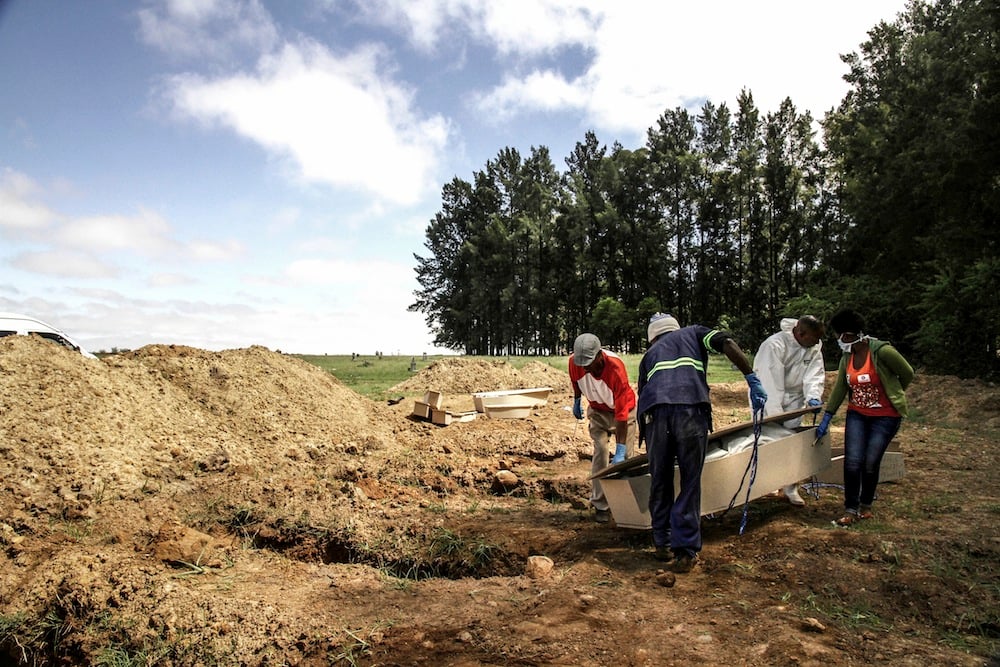South Africa's mortuaries are buckling under the volume of bodies
One in 10 people who pass through Gauteng’s mortuaries is not identified. Their bodies languish for months in overcrowded and under-resourced forensic pathology service facilities, flesh slowly decomposing because a fridge can only slow the inevitable decay for so long.
Eventually, when no one comes for them and they cannot safely be kept any longer, they are carted off en masse to a public graveyard, buried without names, and with no one to mourn them. Once in the ground, their chances of being identified and exhumed dwindle to almost nothing. So do the chances of their families learning what happened, and the chances that the guilty party – if there is one – will be brought to book.
Profesor Ericka L’Abbe, a forensic anthropologist at the University of Pretoria, holds out a skull that is now part of the university’s teaching collection and has been without its skin for a number of years. She points out the star-burst impacts on its surface, which have been glued back together.
“They took out his face. He has at least 10 impacts on his cranium alone … So there is this massive blunt trauma to the head and, in this case, to his hands. They broke his hands as well.”
She sighs and looks up. “But we will never know who this person is. And if you don’t know who they are, you don’t know who did it. You can get away with murder in this country – you just have to throw him in the veld. Or in this case, down a water pipe … All you need is a brick.
“It breaks my heart that no one is looking for him.”
He is not alone. Each year, between 1 300 and 1 600 people in Gauteng are added to the already long list of South Africa’s unidentified dead, at a rate of three people per day. And that is just one province.
“It’s not only in Gauteng,” says Prof Jeanine Vellema, chief specialist of South Gauteng’s eight mortuaries. It is just that data is available for Gauteng, but not for other provinces. “Unidentified bodies are a problem in South Africa – and Africa for that matter.”
 Erika L’Abbe peers through hundreds of boxes containing the remains of unidentified people
Erika L’Abbe peers through hundreds of boxes containing the remains of unidentified people
The journey to an unmourned, anonymous end begins at a mortuary, or as Vellema emphatically corrects, a “medico-legal laboratory” or “forensic pathology service”. These official names imply they are part of a legal investigation.
Johannesburg’s Hillbrow medico-legal laboratory is a busy place on any given Monday. In the shadow of the Constitutional Court, which guards the right to life and human dignity, 30 to 40 bodies are waiting for autopsies. The body fridges, already full to bursting, strain under their numbers.
Last year more than 3 000 bodies entered the peeling yellow walls of the Hillbrow facility, one of the busiest in the country. This year will probably be the same.
Sometimes there is a family waiting in the reception area, a glum room with rows of plastic chairs. If not, the difficult process of attempting to identify the body starts.
At the forensic pathology service, the job of its staff is to find out how someone died, not investigate who they are – that is the police’s job. But as the bodies fill their fridges, they are looking for ways to address this unrelenting deluge.
The forensic staff take facial photos and collect fingerprints and hand this information over to the South African Police Service’s (SAPS’s) investigating officer. After a few days, if no one has come forward to identify the body, the police check the prints against local criminal records and a national database. If that yields no results the prints are sent to the department of home affairs.
Every South African citizen over the age of 16 is supposed to swap their fingerprint data for an identity document, so if the home affairs database shows no matches, the assumption is that the person was a foreigner.
But there is no proof or data to back up this widespread assumption, or even a breakdown of the causes of death for thousands of unidentified people.
If it is true (if there is no proof or data to back up the claim, how do we know it is true?) that many, perhaps most, of the unidentified dead are foreigners, this is a tragedy in itself.
“I don’t think we realise, as South Africans, what our fellow Africans go through – it’s appalling,” says Candice Hansmeyer, a special forensic pathologist at the Johannesburg facility. “People are coming, seeking new lives, they have nothing, and they die, and nobody really cares. But they’re important – they’re somebody’s child, somebody’s daughter, somebody’s mother, somebody’s wife.”
 Hillbrow forensic pathologist Candice Hansmeyer
Hillbrow forensic pathologist Candice Hansmeyer
The trouble with even estimating how many of the unidentified dead are foreigners starts with the obvious problem that we do not know who they are.
“Scientifically, there is no way of knowing – I can’t do a magic test, and say, ‘Okay, this person is from Angola’,” says Stephen Fonseca, the International Committee Red Cross’s forensic co-ordinator for Africa.
We do not even know how many foreign nationals are in South Africa, let alone Gauteng. The 2011 official census puts the total number at 2.2-million, but the real figure is probably higher. According to the United Nations, South Africa is home to the largest number of foreign nationals in sub-Saharan Africa. Complicating matters, many are in South Africa illegally – though again we do not know just how many.
Even if they are here legally, they may have assumed a different name. Sometimes a body will have two or three identity documents on them, Vellema says. “They’ll have a Zimbabwean one, a South African one, and a Mozambican one. And we have to pick a name.”
There are two sides to this coin: a large number of unidentified people means a lot of missing people. This is the case in South Africa, but is an issue that spans a continent. People cross borders, but data does not. There is no continental or regional database for missing people – or for found bodies. In some countries, there is not even a national register.
“If you look across Africa, and ask how many national missing person’s programmes are there, you’re not going to find too many,” says Fonseca, who is working to support forensics in African countries.
South Africa is an anomaly on the continent: it has a robust forensic system, a Bureau of Missing Persons, national databases in both the SAPS and the department of home affairs, universities teaching forensic medicine, and qualified, highly experienced staff.
But this system is groaning under the sheer weight of numbers: Gauteng will see 15 000 to 16 500 cases of unnatural death annually and identification requires investigation. One in 10 will ultimately remain unidentified.
The police are aware of the problem, and its extent. Major General Charles Johnson, acting national divisional commissioner for the detective service issued a strict directive for unidentified bodies in September last year. It says there had been “numerous” complaints that unidentified bodies have been buried without proper investigation, “which caused much embarrassment and taints the image of the service and in particular that of the detective service”.
Hansmeyer stops leafing through that day’s case files – there are four bodies waiting for her in the autopsy room downstairs – and looks up, her lips pulled into a tight line. “The priority [for the police] is the living, and I’m not pointing fingers because we all have this problem: We’re over-burdened, we’re under-resourced… You’re also dealing with burnout and fatigue among the police: there aren’t enough hours in the day, and days in the year to get around to doing everything. One has to prioritise,” she says.
In 2015-16, there were 18 673 murders in South Africa, a 4.9% increase from 2014-15. Citizens and society demand action, and the police have to choose between chasing criminals or identifying mouldering corpses.
Sometimes a passerby discovers a decomposed or burnt body in the veld, with no identity documents. Time and weather have transformed their clothes into unrecognisable tatters. “Where do you start?” asks a senior police official (who spoke on condition that he not be named) tiredly. “We take the body to the mortuary, and if no one comes to claim them, we bury them.”
“Veld bodies” are often a labyrinth with no way out.
A complete and trustworthy list of missing persons to which bodies could be matched would help, but does not exist. Often people do not want to come forward or do not want to report someone as missing. “Some people think it is not going to help, they don’t have trust in police and the justice system,” the officer says.
 Skulls decorate the office of University of Pretoria forensic anthropologist Erika L’Abbe
Skulls decorate the office of University of Pretoria forensic anthropologist Erika L’Abbe
But there are other reasons why a body can be lowered, with two other occupied coffins, into a single six-foot-deep hole in Doornkop, the most recent cemetery to take unidentified and unclaimed bodies in Johannesburg.
It took 23 requests over the course of 18 months to secure an official interview with the police. From silence to a no-reasons-given “no”, the police did not want to engage with queries on the matter until, with no reasons given, we got a “yes”.
Brigadier Helena Ras heads up the SAPS’s Victim Identification Centre (VIC) in Pretoria, with – among other things – the monstrous task of dealing with mass fatalities. A mass death is defined as any incident in which more than five people are killed. These incidents are so common in South Africa that they seldom warrant the top story on a radio news bulletin and seldom make national newspaper front pages: a minibus taxi collides with a car; a shack fire spreads through a township; a building collapses.
Once the dust settles, someone has to sort through the wreckage and rubble, and systematically investigate and identify each body and inform the family.
Look no further than the N1 highway, the route between Johannesburg and Beitbridge on the Limpopo river. In the early hours of 13 August 2015, a minibus hit a truck and caught alight with 12 people trapped inside; on 2 May 2016, there were nine fatalities when a taxi hit an overturned trailer and caught alight.
“Whenever there is an accident like that, you will get the whole engine on fire and you sit with charred bodies,” says Ras from the VIC’s headquarters in Pretoria. Case files in boxes line the one side of her office. There are no passenger lists on taxis. “It is not like a plane or a bus.”
That particular stretch of road is a link between the border and economic opportunities in Gauteng’s cities, so it carries a disproportionate number of migrants. Because of the physical damage sustained in serious accidents, it is often difficult to create a facial reconstruction of what the victim looked like. And while the VIC takes DNA samples, there is nothing to compare DNA to unless a family member comes forward.
The difficulties do not just arise with migrants. Someone living in Tembisa may catch a taxi into nearby Johannesburg. He could die en route, for whatever reason – heart attack, knifing, traffic accident. “Your medico-legal examination is going to happen in Johannesburg,” says Hillbrow’s Hansmeyer.
“It’s nowhere near Tembisa in the East Rand where your community may know your whereabouts. We can’t see from the information we’re given that the deceased is from the East Rand, and we’re not linked by computer with the Germiston mortuary. So we’ve got all these displaced individuals who are not just displaced from their country, but also their community. Their family will only be able to say: ‘He was last seen catching a taxi to work, and he never came back’,” she says.
Still, in such a case, a sufficiently tenacious family can track down the body. It takes time and resources, but it is possible. It also, importantly, requires a family that knows where to look – and that actually does look.
 Undertakers conduct a pauper’s burial in Soweto
Undertakers conduct a pauper’s burial in Soweto
Azwidowi Nevondo dreams of bodies, if she is away from her job for too long. “That’s when I know I have to go back to work,” says Nevondo, who has been a forensic officer at the Hillbrow medico-legal laboratory for a decade.
She has been at it long enough to notice the patterns that only emerge over time, such as the seasonality to the type of bodies that come in.
“Summer time, we receive many decomposed bodies, almost every day, because when it’s hot, you decompose fast,” she says. In winter, shacks catch fire with people sleeping inside them, so there are more burnt corpses.
Once a month, a local-government appointed undertaker comes to the medico-legal laboratory in Hillbrow, and collects the bodies that cannot be held for any longer, sometimes as many as 70 bodies at a time.
A small number are “unclaimed” – which is when the authorities know who the person is, but the family does not claim the body. A smaller number (but one that is rising) are the truly indigent; in this case, families say that they cannot afford a funeral and so the state pays for it. But the largest proportion of the bodies that leave the facility are unidentified.
The law says that they must be held for at least a month, but facilities manager Ina Botes tries to keep the bodies as long as possible in the hope that a family will be found. “It keeps me awake at night that people are going into graves without names. There is a mother somewhere, her son is missing, and in her mind, he is still alive.”
This is happening all over the country and the continent – people think that their family member is still alive, that they have made a life for themselves in Johannesburg, that they are working hard, meeting new people, falling in love. But instead they were hit repeatedly with a half brick, their hands crushed as they tried to protect their head. They were found mummified at the bottom of a drain pipe, and are now a skull in a university professor’s collection.
This is the first story in a three-part series, made possible through a grant from the Taco Kuiper Investigative Journalism Fund, run by Wits Journalism